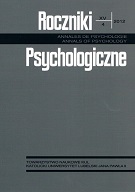Kiedy ostrzeżenie pomaga, a kiedy szkodzi? Wpływ ostrzeżenia na trafność zeznania świadka
When does warning help and when does it harm? The impact of warning on eyewitness testimony
Author(s): Romuald Polczyk, Malwina SzpitalakSubject(s): Psychology
Published by: Towarzystwo Naukowe KUL & Katolicki Uniwersytet Lubelski Jana Pawła II
Keywords: misinformation effect; warning; tainted truth effect; eyewitness testimony; forensic psychology
Summary/Abstract: The presented studies are concerned with the misinformation effect in the context of eyewitness testimony. The main purpose of the experiments was to present the possible consequences (positive ones and negative ones) of warning participants about inconsistencies between original and postevent materials to the quality of memory report. Another aim of the studies was to include an additional stage in the typical procedure of researching misinformation effect: the presentation of an additional postevent material. In both experiments, after the original material was shown to them, participants were exposed to two postevent materials. One of the materials correctly repeated the information from the original material or contained neutral information, while the other one included some misleading information. The two experiments differed in the sequence of the exposition of postevent materials. In the first study, misinformation manipulation was used in the first material. In the second study, the first postevent material was neutral or contained information correctly repeated from the original material. As expected, in Experiment 1 the tainted truth effect was observed, whereas in Experiment 2 warning eliminated the misinformation effect.
Journal: Roczniki Psychologiczne
- Issue Year: 15/2012
- Issue No: 4
- Page Range: 51-72
- Page Count: 22
- Language: Polish

